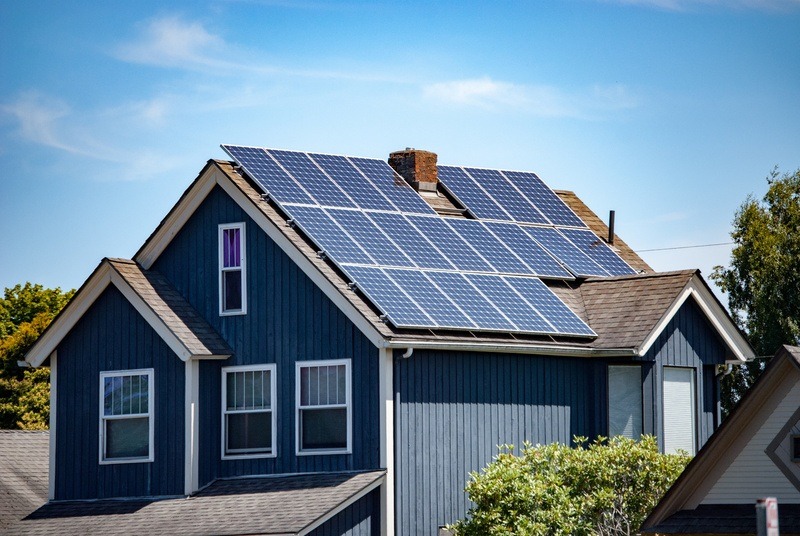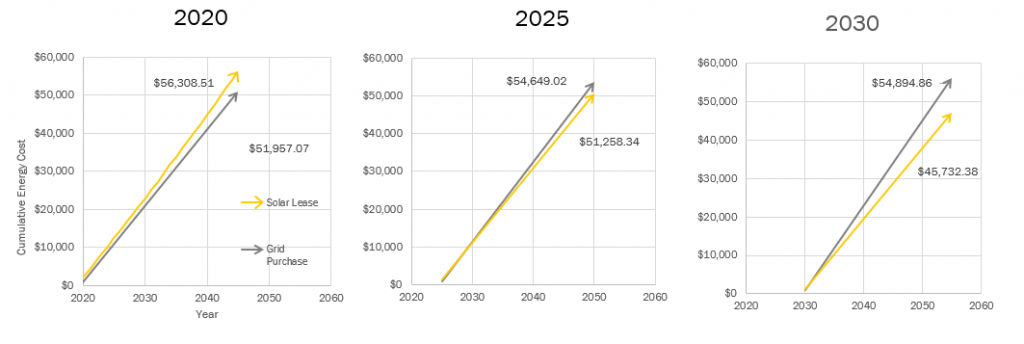Emma Bowman, MEL in Clean Energy Candidate | December, 2020
APPP 506 – Master of Engineering Leadership Capstone Project, University of British Columbia
Acknowledgement: This project was inspired and supported by Michael Pullinger from Energy Revolution Services.
Abstract

There is an increasing need and obligation to reduce British Columbia’s Greenhouse gas emissions in the foreseeable future. Residents can contribute to reducing GHG emissions through grid electrification with the installation of solar PV systems. The largest barrier for installing residential solar modules is the hefty up-front cost. Several U.S. states have overcome this issue with the the option of third-party-ownership (TPO) wherein the resident makes annual lease payments for a solar installation. This study aims to assess the viability of TPO of solar PV systems in BC.
To determine the viability of TPO of solar PV systems in BC, a 3-part analysis was performed to assess the viability from corporate, consumer, and investor perspectives. First, a sensitivity analysis was performed to determine which inputs to the cost of solar installations in a TPO scenario have the greatest impact on the levelized cost of energy (LCOE). Second, from a consumer perspective, market trends were projected into the future in order to assess the financial benefit of signing a solar lease agreement vs. purchasing electricity from the grid. Lastly, given current market conditions, the rate of return for investors wanting to invest in a solar leasing company was calculated and discussed.
The results showed that the capital cost has the largest impact on the LCOE that can be offered by a third-party. This is followed by location (i.e. irradiance) and lease period. From a consumer standpoint, a 25-year solar lease was shown to not yield any savings until the year 2025, given increasing grid electricity rates, and decreasing solar PV hardware costs. Lastly, a modest rate of return of 6% can be offered to investors at present in order for TPO to be a viable business model in BC. These results suggest that the province is on the cusp of being able to offer TPO to an untapped market of future residential solar adopters, but not until 5 to 10 years from now.
Introduction
Under the Climate Change Accountability Act (CCAA) [1] assented in 2007, BC’s Greenhouse Gas (GHG) emissions “are to be reduced by at least 40% below 2007 levels by 2030, 60% by 2040, and 80% by 2050.” In order to hit these targets with increasing energy demand, a variety of energy sources will need to be implemented on the residential and utility level. In 2015, the Canada Energy Regulator [2] reported that the electricity sector in Canada was responsible for 11% of Canada’s GHG emissions, and that residential consumption was associated with approximately 4% of Canadian GHG emissions. Compared to the rest of Canada, BC has a relatively low GHG emissions per capita for residential electricity consumption, as most of BC’s electricity comes from Hydro., However, BC residents adopting solar installations can assist with further decarbonization of household energy use (for example, switching to electric vehicles or switching to heat pumps) by supplying clean energy to substitute these other fossil fuel sources. Solar adoption in BC can also set an example for future residential solar adopters in other Canadian jurisdictions. The question lies in how do we get residents to choose to install solar PV systems on their homes?
Decreasing hardware costs, along with policy support is driving down the cost of solar PV systems. Several states in the US have demonstrated successful uptake of third party ownership (i.e. leasing) of solar PV systems by new consumer markets [3]. This study aims to assess the viability of TPO of solar PV systems in British Columbia.
Given BC’s relatively low carbon-intensity for electricity, the role that new renewable energy sources can really play in terms of sustainability is assisting with “electrification”. For a residential household, some key examples might be switching to electric vehicles, or switching to heat pumps (both of which eliminate a ‘fossil fuel’ source of energy over to electricity, and have a substantial impact on carbon emissions). Obviously, there is no need for a household to switch either over to electricity to put solar on their rooftop, but I think it helps frame the discussion – i.e. why would we want to install more renewable energy in BC despite already being fairly low carbon intensity?
Purpose
Conduct a study to compare the levelized cost of energy (LCOE) for a solar lease agreement versus buying electricity from the grid in British Columbia to evaluate the feasibility of a third-party ownership (TPO) business model in the province.
Objectives
- Prepare a sample business model for a TPO solar business in BC.
- Perform a sensitivity analysis to determine what factors have the largest impact on the levelized cost of energy in British Columbia, and which need to shift in order for residential solar PV installations to become more appealing for residential installations.
- Perform an investigation of energy market trends and their effect on the feasibility of residential solar installations.
- Discuss the financial feasibility for investors interested in investment in solar leasing companies.
Method
The analysis consists of three parts. First a sensitivity analysis where the sensitivity parameters outlined in Table 1 are varied to observe their effect on the LCOE. Second, an analysis of the current pricing trends in the BC electricity market for the cost of electricity and the cost of solar panels. Lastly, an analysis on the desirability to invest in a solar leasing company which would ultimately determine the success of a potential business. For this analysis, the LCOE was used a means of comparing different scenarios. The process to calculate the LCOE is described below and the financial model in spreadsheet form is provided in Appendix A of the final report.
Assumptions
- The step 2 rate for electricity of $0.1403/kWh was used for comparison in evaluating the benefit of a solar leasing program. Using this rate is both conservative, as it is the higher of the two rates, and it is also more accurate. The average size of a solar installation on a residential home is 4kW-5kW.
- The average annual energy demand of a detached home in British Columbia is 15000 kWh. This is based on research and from sample energy bills. Energy demand fluctuates throughout the year, with a low of around 550kWh during the summer months, however for this study an average demand of 15000/12=1250 kWh was assumed to be the monthly consumption.
- Inverter replacement cost not included in NPV calculations
- Tear-down costs not included at the end of the project life. This is usually $1000-$3000.
- Annual O&M costs were assumed to remain constant.


Data Selection

These are the parameters that remained fixed during my sensitivity analysis. All of the values were selected based on general research and typical values at the present time. I chose a 4.62kW solar installation that was south-facing with a 25 degree tilt.
The financing parameters are inputs to the weighted average cost of capital that I explained earlier, which was used as the discount rate in the net present value calculation for the LCOE. These values are ultimately indicators of the risk associated with a business structure.

These are the sensitivity parameters that were varied in the analysis – in other words, these are the variables that were adjusted in order to determine the magnitude of change that they induced on the levelized cost of energy. I varied the corporate tax rate from 5 to 9%,. Selected 3 cities in BC with varying irradiance values, 3 lease periods, and capital costs ranging from 8000 to 20000. As mentioned, capital costs can range anywhere from 10 to 30,000 dollars. The baseline value used was 12,000 as this would be the approximate cost of the panels that were selected.
Sensitivity Analysis
To determine which variables have the highest influence on the LCOE, the following steps were performed:
- The baseline LCOE was calculated using the “baseline” values in Table 2.
- One variable at a time was set to lower and upper bound values, and the LCOE was recorded in Excel.
- The results were normalized by percentage by calculating the percent change in each of the sensitivity parameters was plotted against the LCOE on the same scatter plot.
- The sensitivity values for each variable – meaning the dimensionless slope of the line relating the % change in LCOE and % change in sensitivity parameter – were plotted in a bar graph.
Note that the relationships between LCOE and each of location, and lease contract length were non-linear. These relationships were approximated with a linear best fit line as means for comparison; however, this implies that the sensitivity analysis is valid for only a small range of values.
Market Forecast
The cost of electricity and solar equipment is rapidly changing. Given recent trends it was forecasted that the grid cost of electricity in BC will continue to increase at a rate of 5% every 5 years which roughly matches the rate of inflation [15] [16]. Based on research [17], the cost of solar hardware has been decreasing exponentially at 5% per year. Assuming that these trends continue for the foreseeable future, the cumulative cost of energy for a residence in BC was calculated comparing buying energy from the grid, versus entering a solar leasing agreement:
- Annual electricity costs from the grid, and LCOE costs in a solar lease agreement were projected forward to the year 2055.
- The annual cost for purchasing electricity from the grid was calculated for every year:
- The cumulative cost of purchasing electricity from the grid over a 25-year period was calculated by summing the annual costs for 25 years, starting from years 2020, 2025, and 2030.
- A reasonable annual lease cost for the customer was approximated:
- Assuming an installation in Vancouver, and an average consumption of 2500kWh in a bi-monthly billing cycle, the amount of electricity charged at the step 1 electricity rate is 1350kWh. This left 2500kWh-1350kWh= 1150kWh charged at the step 2 rate under the net metering program.
- With a solar installation in Vancouver producing 5742kWh of electricity annually (obtained from RETScreen Expert), this equates to an average of 5742kWh/6=957kWh generated per billing cycle.
- This left (1150kWh-957kWh)*6=5943kWh annually to be charged at the grid step2 rate.
- The remaining 5943kWh of demand was assumed to be met by the solar installation.
- A lease payment approximated by 5943kWh*(LCOE of the leasing company) would only be sufficient for the leasing company to break even (determined with a NPV calculation). As such, an additional 20% which is enough to make a profit for the solar leasing company and for the consumer to save money on their annual electricity bill. Therefore, the annual lease cost was approximated to be 5943kWh*(LCOE of lease in year 1)*(1.20). Details can be found in the appended spreadsheet.
- The cumulative cost of purchasing electricity from the grid plus paying annual lease payments was calculated by summing the annual costs of buying 1543kWh per billing period from the grid similar to 2., and paying the annual lease payment calculated in 4.
- The total savings for the consumer was calculated by subtracting the cumulative energy costs for purchasing from the grid, vs. a solar lease for the 25-year periods starting in 2020, 2025, and 2030.
Investment Evaluation
Recall that for cost of equity was fixed for the first portion of this analysis. The cost of equity is essentially the risk that an investor is accepting when providing capital to a business. Given the current capital cost, grid rate, demand, etc. the following was performed to find the breakeven LCOE for a solar leasing company in 2020 (i.e. when the LCOE equals the electricity rate offered by BC Hydro):
- Set all parameters to baseline values.
- Use the Goal Seek formula in MS Excel: set the LCOE equal to the grid rate ($0.1403/kWh) by changing the equity rate.
Results and Discussion
Sensitivity Analysis

This plot demonstrates the magnitude by which the LCOE changes as the sensitivity variables are altered by various percentages from their baselines. Best fit lines with steeper slopes indicate a higher sensitivity. For example, the capital cost line has the highest slope, which indicates that it is the most sensitive – in other words, has the highest impact on the LCOE.

With these normalized results, it is obvious that out of all of the parameters examined, the capital cost of the installation ultimately dictates the Levelized cost of Energy in a Leasing arrangement, followed by the location and the lease period. That being said, let’s take a look at what happens to the cost of electricity through a lease agreement vs. buying from the grid as technology develops…
Market Forecast
Here are the cumulate energy spending over a 25-year period beginning in 2020, 2025, and 2030. In 2020, from the consumer perspective, there would be no savings from having a lease agreement over buying electricity from the grid, in 2025, there are some savings, but as we look further into the future, say 2030, the savings become increasingly significant as the lines diverge.

Investment Evaluation

At present, for a solar leasing company to be able to break even, i.e. for the company to be able to offer an LCOE equal to the grid rate, with the financial structure set in this study, investors could expect a 6.9% return on investment. Though this should be sufficient to attract investment, the company itself as well as consumers seeking a lease, would likely not yield sufficient financial benefits for the model to be viable at this time.
Conclusion
We can conclude from this analysis that the largest impact on the viability of solar leasing models in British Columbia is the capital cost of the installation itself, and the cost of electricity from the grid. Location (i.e. irradiance) obviously does have an impact on the return on investment of solar installations, however with the current market trends discussed in this report, the solar insolation dictates the “when” and not the “if” when it comes to the viability of a solar leasing pricing scheme. Savings for consumers interested in a solar lease agreement will begin to exist starting in 2025, and will continue to increase over time if grid cost and hardware cost trends continue. From an investor’s perspective, an investment in a solar leasing company would currently yield a 6% return. At the moment, at least in BC, from a financial perspective, a solar lease is not yet a viable business model. However, there is a significant market for residential solar installations that are awaiting the availability of a leasing option, that will likely be viable in the next 5-10 years.
Contact

I welcome any questions or comments on the work that I have done in this study. Please feel free to contact me via
email: emmabowman23@gmail.com
LinkedIn: https://www.linkedin.com/in/emmalbowman/
References
| [1] | BC Government, “Climate Action Legislation,” 2020. [Online]. Available: https://www2.gov.bc.ca/gov/content/environment/climate-change/planning-and-action/legislation#:~:text=Under%20the%20Act%2C%20B.C.’s,path%20to%20our%202030%20goal.. |
| [2] | Canada Energy Regulator, “Market Snapshot: Greenhouse gas emissions associated with resoidential electricity consumption vary significantly by province and territory,” 2017. [Online]. Available: https://www.cer-rec.gc.ca/nrg/ntgrtd/mrkt/snpsht/2017/06-04grngsmssnsrsdntl-eng.html#:~:text=The%20electricity%20sector%20was%20responsible,4%25%20of%20Canadian%20GHG%20emissions.. |
| [3] | Drury, “The Transformation of Southern California’s residential photovoltaics market through third-party ownership,” Energy Policy, pp. 681-690, 2012. |
| [4] | BC Hydro, “Distributed Generation Technical Interconnection Requirements 100kW and Below (DGTIR-100), Rev 1,” BC Hydro, Vancouver, 2014. |
| [5] | BC Hydro, “Generating your own electricity,” 2020. [Online]. Available: https://www.bchydro.com/work-with-us/selling-clean-energy/net-metering.html. |
| [6] | M. Varun Rai, “Overcoming barriers and uncertainties in the adoption of residential solar PV,” Renewable Energy, pp. 498-505, 2016. |
| [7] | B. S. Varun Rai, “Diffusion of environmentally-friendly energy technologies: buy versus lease differences in residential PV markets,” Environmental Research Letters, 2013. |
| [8] | S. C. &. S. Reichelstein, “Cost competitivenss of residential solar PV: The impact of net metering restricitions,” Renewable and Sustainable Energy Reviews, pp. 46-57, 2017. |
| [11] | M. Pullinger, Interviewee, Principal, Energy Revolution Services. [Interview]. 2020. |
| [12] | EnergySage, “Types of Solar Panels,” 2020. [Online]. Available: https://www.energysage.com/solar/101/types-solar-panels/. |
| [13] | Corporate Finance Institute, “Levelized Cost of Energy (LCOE),” [Online]. Available: https://corporatefinanceinstitute.com/resources/knowledge/finance/levelized-cost-of-energy-lcoe/. |
| [14] | M. Hargrave, “Weighted Average Cost of Captial- WACC,” 20 April 2020. [Online]. Available: https://www.investopedia.com/terms/w/wacc.asp. |
| [15] | “BC Hydro News Release,” [Online]. Available: https://www.bchydro.com/news/press_centre/news_releases/2020/statement-one-per-cent-rate-reduction.html. |
| [16] | “BC Hydro Rates Decrease Application,” [Online]. Available: https://www.cbc.ca/news/canada/british-columbia/bc-hydro-rates-decrease-application-1.5258128. |
| [17] | “News. Energysage.com,” [Online]. Available: https://news.energysage.com/solar-panel-efficiency-cost-over-time/#:~:text=Over%20a%20decade%20ago%2C%20in,installation%20was%20%248.50%20per%20watt.&text=The%20result%3A%20the%20price%20of,%2C%20to%20just%20%242.91%2Fwatt.. |
| [18] | [Online]. Available: https://www.energyhub.org/cost-solar-power-canada/#system-sizing. |
| [19] | “Cost and Performance Review of Generation Technologies,” [Online]. Available: https://www.nwcouncil.org/sites/default/files/E3_GenCapCostReport_finaldraft.pdf. |